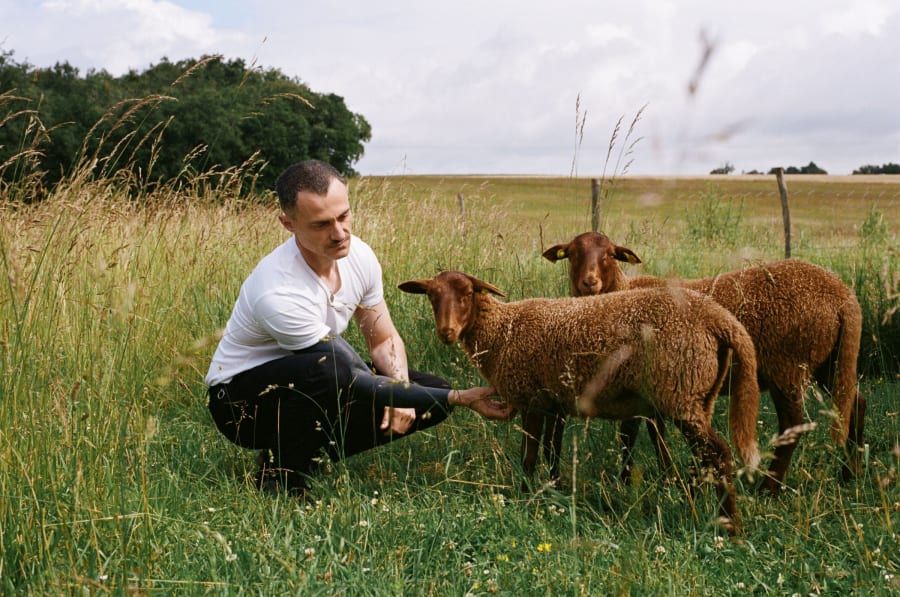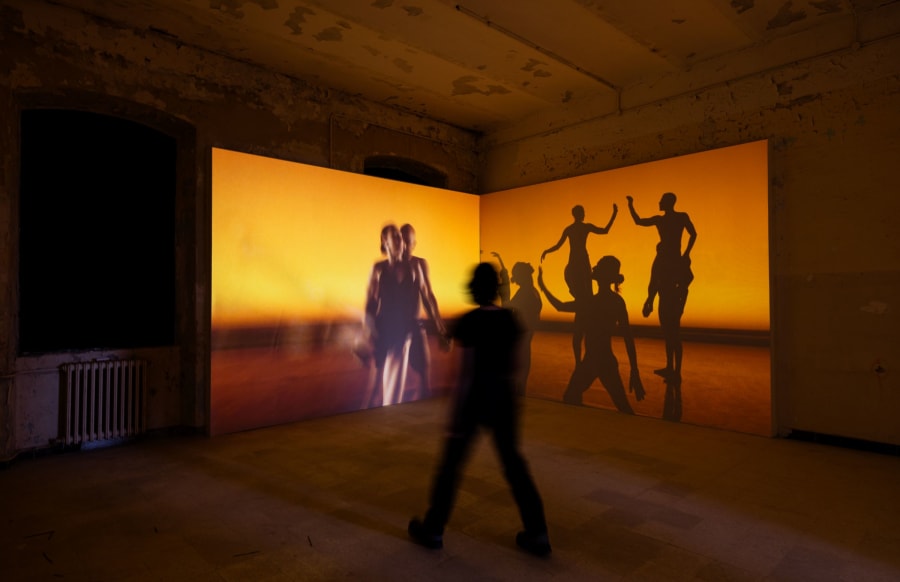From Lake Geneva and Lake Maggiore to Lake Lucerne, Switzerland’s picturesque lakes are as much a part of the country’s DNA as its world-famous mountains. A number of artists have found intriguing motifs in them, most prominent among them Ferdinand Hodler (1853-1918), who sketched and painted them relentlessly. To Hodler, landscapes were almost sentient, full-fleshed individual characters. Similarly, various contemporary artists have set out to capture the essence of Swiss lakes, all in their own unique way.
Lakes appear repeatedly in the dreamlike landscape paintings of Andriu Deplazes (b. 1993), which often seem to toggle notions of confinement and openness. In Kletternde (2020), a shoreline divides the painting horizontally. In the foreground, rocks protrude into the water, serving as the base for a single tree sprouting pink blooms and a sole figure that appears to be climbing. The human figure is depicted amid nature, yet curiously detached from it – a key concept in Deplazes’s work. Through his meticulously composed arrangement and captivating use of color, a mountain lake takes on a symbolic quality, evoking a sense of longing for a place that remains just out of reach.
Pour le peintre Thomas Huber (né en 1955), le lac devient un lieu de retour aux sources. « Lago Maggiore », le titre de son exposition personnelle au MASI Lugano qui s’est tenue en début d’année, a marqué un tournant dans son travail. Les plus grandes toiles exposées sont débarrassées des éléments architecturaux qui définissaient ses œuvres antérieures. L’une d’elles, intitulée Am Abend (2023) et réalisée dans un format panoramique de 3 mètres de long, offre une expérience presque immersive du lac au crépuscule. Montrée d’un point de vue en hauteur, l’étendue d’eau est encadrée de collines fortement stylisées et de formes rondes évoquant des arbres. Les silhouettes des bâtiments et les lumières scintillantes sur les rives induisent une certaine contemporanéité, tandis que le motif de la vue sur le lac est exécuté avec une perfection épurée qui exprime l’intemporalité. De retour dans la région frontalière entre la Suisse et l’Italie après avoir passé plusieurs dizaines d’années à Berlin, Thomas Huber fait preuve d’une dévotion et d’une observation minutieuse du paysage local qui répond à un besoin universel de se sentir ancré et chez soi quelque part dans le monde.
Leiko Ikemura (b. 1951) has been heralded for infusing European painting traditions with Japanese philosophy. The multidisciplinary artist, who grew up in Japan and spent time in Spain, Switzerland, and Germany, has said that Swiss landscapes ‘such as the mountains and the lakes’ are deeply ingrained in her mind. The medium-sized panel Mountain Lake (2010/2011) shows a landscape on the verge of dissolving into abstraction. The lake has all but disappeared, with only a thin blue line connoting its edge. In the hands of Ikemura, the landscape becomes a portal that allows viewers to find commonality with nature. Ikemura has stated that she believes lakes to be universal landscapes, ‘a kind of prototype.’ In its own way, this stance may be the most direct continuation of Ferdinand Hodler’s legacy, and his search for the ‘essential.’
Jean-Frédéric Schnyder’s (b. 1945) approach to painting lakes is decidedly more pragmatic. Schnyder has demonstrated an insatiable appetite for new motifs and painting styles, depicting everything from clowns, highways, and overpasses to the family’s Tibetan Terrier Dritchi and mountain summits marked with glowing pink crosses. In 1996, he captured the sunset on Lake Zug in central Switzerland 163 times, riding a bike the short distance from his home to find a suitable view, and using what little time was left before the sun disappeared behind the horizon to finish his small-scale paintings en plein-air. All works in the series show the same basic arrangement; any discernible variation is due to light and weather conditions – or the occasional appearance of a swan. Schnyder is not seeking mythical transfiguration. His technique is often flat and intentionally naive, amateurish, badly painted or approximate. It is as if the painter is saying: ‘I’m not trying to make it beautiful, and I can’t help it if you see it that way.’ Schnyder applies the same logic to all the motifs he depicts, embracing a non-hierarchical logic that forces the viewer to consider his works with a quintessentially Swiss sort of cool distance.
Lake Geneva is a source of constant inspiration for Caroline Bachmann (b. 1963), who lives and works in Cully, a charming medieval village on its shores. Her practice of repeatedly painting the view from her home has taken on the sort of mythic quality associated with great artistic figures. The daily ritual, which is said to take place at night or in the early morning hours, consists of Bachmann sitting down to sketch the lake as it appears in that particular moment, noting the lighting and weather conditions, and adding details such as clouds, waves, or whatever else strikes her fancy. In Risée croissant de lune (2021), the act of contemplation manifests itself as a barely visible sliver of a rising new moon while the remnants of daylight disappear behind a darkened mountain range. To Bachmann, the lake is a source of restoration, a container for vibrations, a theater of matter, and offers inspiration on a silver platter. She treats each element as if it were a character in a scene.
Last but not least, Roman Signer (b. 1938), decidedly not a painter, has found an ingenious way to add his own version of a lake vista to his oeuvre, with the site-specific and permanent installation Seesicht (2015). Placed prominently on the lakeside promenade in Zug, the steel sculpture consists of a staircase leading well below the water level and offering an unfamiliar view of the lake through a large window. Depending on the time of day, one might see fish swimming close by, or rays of sunlight penetrating the water surface above. This artistic natural observatory is in keeping with the artist’s core interest in physical elements in motion. To Signer, the lake is less something to be looked at, but rather a force of nature to be experienced.
It is curious to think about how the lakes of Switzerland have triggered different artistic responses. Seen through the eyes of these artists, the lake might be a magical subject, a sentient counterpart, a portal, a stylistic device, or a source of restoration. If you have ever spent a day at a lake, observing the changing light and weather, you might have your own notion to add, and let me be the first to tell you that you, too, are right.
Andriu Desplazes is represented by Galerie Peter Kilchmann (Zurich and Paris). Thomas Huber is represented by Skopia / P.-H. Jaccaud (Geneva). Leiko Ikemura is represented by Galerie Karsten Greve (Cologne, St. Moritz, Paris) and Lisson Gallery (London, Los Angeles, New York, Shanghai). Jean-Frédéric Schnyder is represented by Galerie Eva Presenhuber (Zurich, Seoul, Vienna). Caroline Bachmann is represented by Galerie Gregor Staiger (Zurich, Milan) and Meyer Riegger (Berlin, Basel, Karlsruhe, Seoul). Roman Signer is represented by Art : Concept (Paris), Galerie Martin Janda (Vienna), and Hauser & Wirth (Zurich, Hong Kong, London, Los Angeles, New York, Paris, Somerset, St. Moritz).
Rebecka Domig is an art historian, writer, and curator at Kornhausforum, Bern.
Caption for top image: Jean-Frédéric Schnyder, 411 Der Niesen am 21. Dezember (detail), 1987. Collection Ringier. Courtesy of the artist and Galerie Eva Presenhuber. © The artist.
Published on July 30, 2024.


